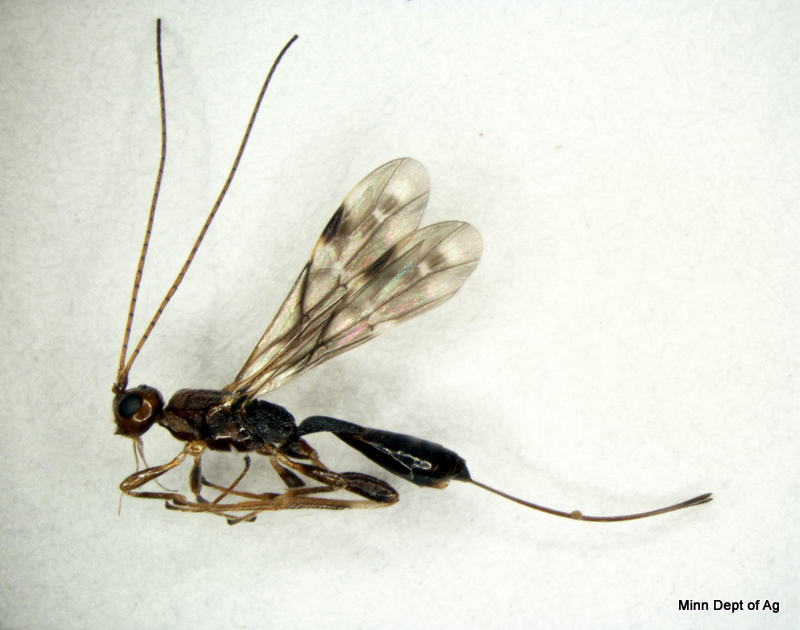Tetrastichus planipennisi (larval parasitoid)

Tetrastichus planipennisi Yang (Hymenoptera: Eulophidae) are small parasitoids (1.6 to 4.1 mm long). Adult females locate EAB larvae under ash bark and insert eggs into EAB larva. Parasitized EAB larva remain active for approximately one week although the parasitoids develop within and eventually consume the EAB larvae. Tetrastichus planipennisi larvae pupate inside the EAB gallery and emerge approximately 15 days after pupation by chewing an exit hole through the bark. They overwinter as larvae within the host or host gallery. Approximately 4-172 progeny are produced per EAB larva. In China, T. planipennisi completes four or more generations per year and parasitism levels range from 0-65%.

Tetrastichus planipennisi Yang (Hymenoptera: Eulophidae) are small parasitoids (1.6 to 4.1 mm long). Adult females locate EAB larvae under ash bark and insert eggs into EAB larva. Parasitized EAB larva remain active for approximately one week although the parasitoids develop within and eventually consume the EAB larvae. Tetrastichus planipennisi larvae pupate inside the EAB gallery and emerge approximately 15 days after pupation by chewing an exit hole through the bark. They overwinter as larvae within the host or host gallery. Approximately 4-172 progeny are produced per EAB larva. In China, T. planipennisi completes four or more generations per year and parasitism levels range from 0-65%.

Tetrastichus planipennisi Yang (Hymenoptera: Eulophidae) are small parasitoids (1.6 to 4.1 mm long). Adult females locate EAB larvae under ash bark and insert eggs into EAB larva. Parasitized EAB larva remain active for approximately one week although the parasitoids develop within and eventually consume the EAB larvae. Tetrastichus planipennisi larvae pupate inside the EAB gallery and emerge approximately 15 days after pupation by chewing an exit hole through the bark. They overwinter as larvae within the host or host gallery. Approximately 4-172 progeny are produced per EAB larva. In China, T. planipennisi completes four or more generations per year and parasitism levels range from 0-65%.
Spathius galinae (larval parasitoid)

Spathius galinae Belokobylskij and Strazanac (Hymenoptera: Braconidae) are small parasitoids. Adult females locate EAB larvae under ash bark, paralyze and lay eggs on the outside of the EAB larva. Parasitoid larvae develop and consume the EAB larva. S. galinae larvae pupate inside the EAB gallery and emerge approximately one month later by chewing an exit hole through the bark. They overwinter as larvae within the host gallery. Approximately 5-12 individuals are produced per EAB larva. In the Russian Far East, S. galinae completes two generations per year with parasitism rates averaging 63%.

Spathius galinae Belokobylskij and Strazanac (Hymenoptera: Braconidae) are small parasitoids. Adult females locate EAB larvae under ash bark, paralyze and lay eggs on the outside of the EAB larva. Parasitoid larvae develop and consume the EAB larva. S. galinae larvae pupate inside the EAB gallery and emerge approximately one month later by chewing an exit hole through the bark. They overwinter as larvae within the host gallery. Approximately 5-12 individuals are produced per EAB larva. In the Russian Far East, S. galinae completes two generations per year with parasitism rates averaging 63%.

Spathius galinae Belokobylskij and Strazanac (Hymenoptera: Braconidae) are small parasitoids. Adult females locate EAB larvae under ash bark, paralyze and lay eggs on the outside of the EAB larva. Parasitoid larvae develop and consume the EAB larva. S. galinae larvae pupate inside the EAB gallery and emerge approximately one month later by chewing an exit hole through the bark. They overwinter as larvae within the host gallery. Approximately 5-12 individuals are produced per EAB larva. In the Russian Far East, S. galinae completes two generations per year with parasitism rates averaging 63%.

